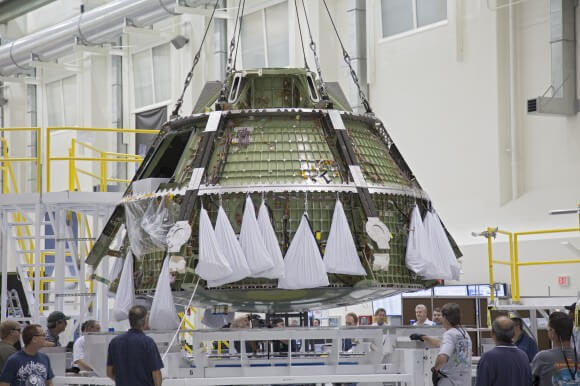A representative of Universe Today was sent to follow the progress of the construction of the Orion capsule at the Kennedy Space Center. On its last visit, the Orion train seemed like a beehive with a lot of activity by technicians.

Last week, a test of the parachute system was conducted and passed successfully despite "malfunctions" of not opening some of the parachutes
An experimental version of NASA's Orion spacecraft landed safely during a test in which two of its parachutes failed.
In the experiment, conducted in Yorena, Arizona, the simulation capsule flew at a speed of about 400 km/h when the parachutes opened. This is the highest luminosity the spacecraft has experienced so far as part of a series of experiments designed to validate Orion's human-carrying parachute system.
In one of the experiments, the engineers staged the non-opening of one of the three parachutes that skipped the first stage of inflation after being thrown from a plane at an altitude of 25 feet above the Arizona desert. The parachutes are used to slow and orient the spacecraft while the main parachute inflates.
NASA and Lockheed Martin are preparing to move ahead of schedule
NASA is advancing the schedule for assembling the Orion passenger capsule at the Kennedy Space Center in Florida and is speeding up the procedures for the launch of an unmanned test flight (EFT-1) planned for September 2014 on a Delta-4 rocket in its heavy version. This rocket is supposed to be the one that will enable the Orion flight in the future for manned journeys into deep space - near-Earth asteroids or even Mars.
A representative of Universe Today was sent to follow the progress of the construction of the Orion capsule at the Kennedy Space Center. On its last visit, the Orion train seemed like a beehive with a lot of activity by technicians.
"We plan to turn on the electrical systems in Orion for the first time this summer," says Scott Wilson in a special interview with Universe Today alongside the spacecraft. Wilson is the director of production operations (it doesn't sound good in Hebrew.. I suggest: "operations and production" or just "production") of Orion on behalf of NASA at the Kennedy Space Center.
The EFT-1 flight is the first critical step toward achieving NASA's new goal of bringing a near-Earth asteroid into low Earth orbit and, eventually, flying astronauts to a larger asteroid in 2021 if NASA's budget request is approved.
Artist's impression showing Orion as it will appear in space on the first test flight, when attached to the second stage of the Delta 4 rocket. Photo: NASA
The Kennedy Space Center has an important role in the asteroid retrieval project. The project may be completed four years earlier than the target year set by Obama - for the mission of landing on an asteroid - 2025.
Capturing an asteroid and sending astronauts aboard the Orion spacecraft to collect soil samples will help scientists understand the formation of the solar system and advance the planetary defense strategy. The importance of the planetary defense strategy was made clear when a meteor hit Russia in February of this year and indirectly injured 1,200 people and damaged 3,000 buildings.
Dozens of skilled workers were busy cutting metal, drilling holes, tightening screws and connecting a wide variety of mechanical and electrical components to the Orion's compressed cabin. The service module and other components were also seen in the field.
EFT-1 cabin and scale rendering showing the crew component atop the service module inside the assembly building at the Kennedy Space Center. Photo: Ken Cramer. /kenkremer.com
Lockheed Martin is Orion's prime contractor. "Lockheed Martin (and?) United Space Alliance recently hired an increasing number of workers for two shifts, seven days a week to complete the job assembly by the end of the year." Jules Schneider, director of the Orion project at Lockheed Martin, told Universe Today.
A Universe Today representative writes: "We watched the boring part of drilling precise holes and carefully tightening steel screws to connect the upper and lower titanium ring components to the compressed part."

3 תגובות
skeptic,
I'm considering a copyright claim on the nick. Just them.
Regarding the capsule. From what I understand, these are not space trips where they ever considered using human pilots. According to my understanding, these are *deep space* journeys where the spacecraft flies for many years in space without any parking. Is there a pilot willing to fly in space for 20 years without parking?
"Orion for manned journeys into deep space" is a "can" that at most can be used to reach the moon with people,
To go further you need something bigger, maybe if Orion connects to something bigger,
In any case, you see the state of the astronauts touching the earth after six months
It is difficult to see them being productive in reaching Mars after about 7 months even with the smaller gravity there
They are not waiting there with a comfortable chair and bread, there is a good chance they will lie down like jellyfish and it will take them a long time to recover,
Apparently, an artificial force of gravity must be created for the entire journey there, and this cannot be done in the Orion vehicle either,
A supply spacecraft is sent to the International Space Station every few months, it needs all the supplies there
This requires a large volume again this cannot be done in Orion,
Orion looks more like a small shuttle that takes you to space and brings you back that is based on old and reliable technology,
Unlike the space shuttle, which had a large complexity and weight that cost a fortune to send up.
Proofread, ladies, proofread!